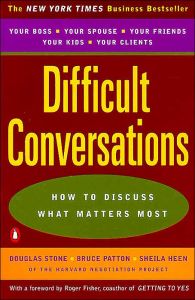You will face difficult conversations throughout your life, but now you can learn how to cope with them. This book provides a framework and various strategies for achieving better outcomes from hard exchanges. Douglas Stone, Bruce Patton, and Sheila Heen use principles, illustrative stories, and charts to teach you how to understand the components of challenging conversations, and how to prepare for them and transform them into something constructive. The language of the book is clear, insightful, concise, and always helpful. You can use these principles in business, but the stories also concern relationships in your everyday life. Everyone from teenagers to mature adults can use the communication skills discussed in this wise book.
The “Three Conversations”
Do you ever avoid certain people because you don’t want to have a conversation that you need to have? As you imagine how the conversation might play out, do you feel queasy and apprehensive? This is a normal reaction, but avoiding difficult conversations is not the solution. In fact, often it will make things worse. Yet, experience tells you that having the conversation will create a very uncomfortable situation. You wrestle with different approaches and look for just the right diplomatic language to avoid a confrontation.
However, certain methods can help you deal with this circumstance. Every conversation has a three-part structure, even if the participants don’t realize that such an underlying framework exists. The structure is built on conversations within the conversation. Understanding these internal conversations can help you avoid the pain of letting difficult talks run their usual course.
The first part of a conversation is “What Happened?” This section, which is about assigning blame and fault, and asserting dominance, can lead to struggles and bad feelings.
The second part is about “Feelings.” Whose feelings are appropriate...
Douglas Stone, Bruce Patton, and Sheila Heen are professors at Harvard Law School and are part of the Harvard Negotiation Project. They have each written, spoken and consulted on negotiation and communication.
















Comment on this summary